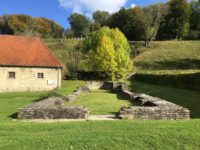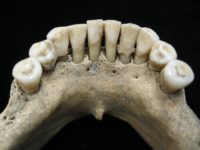A team of researchers led by the Max Planck Institute for the Science of Human History and the University of York have discovered lapis lazuli embedded in the dental tartar of a medieval woman. The presence of this extremely expensive pigment in her teeth indicates that the woman was a manuscript illustrator of the highest caliber.
 She was buried around 1100 A.D. in the cemetery of a small monastery in Dalheim, western Germany. The woman’s monastery is in ruins today with only a few architectural remains still surviving. The date of its founding is unknown (it might have been as early as the 10th century) with the earliest written records dating to 1244. It was destroyed by fire in the 14th century, but until then it was home to a small community of just over a dozen religious women.
She was buried around 1100 A.D. in the cemetery of a small monastery in Dalheim, western Germany. The woman’s monastery is in ruins today with only a few architectural remains still surviving. The date of its founding is unknown (it might have been as early as the 10th century) with the earliest written records dating to 1244. It was destroyed by fire in the 14th century, but until then it was home to a small community of just over a dozen religious women.
The skeletal remains of the woman were analyzed as part of a project to study dental calculus that forms on the teeth during life and calcifies. Stable isotope analysis of hardened plaque specimens can identify what people ate. Or ingested, as must have been the case of the woman with blue pigment particles embedded in her plaque.
 She was between 45 and 60 years old at the time of her death. There is no sign of an explicit cause of death on her skeleton — no evidence of illness, injury, infection or repetitive motion or stress. Only one unusual feature stood out: the blue stain on her teeth. Spectographic analysis revealed that the blue came from lapis lazuli.
She was between 45 and 60 years old at the time of her death. There is no sign of an explicit cause of death on her skeleton — no evidence of illness, injury, infection or repetitive motion or stress. Only one unusual feature stood out: the blue stain on her teeth. Spectographic analysis revealed that the blue came from lapis lazuli.
“We examined many scenarios for how this mineral could have become embedded in the calculus on this woman’s teeth,” explains [University of York researcher Anita] Radini. “Based on the distribution of the pigment in her mouth, we concluded that the most likely scenario was that she was herself painting with the pigment and licking the end of the brush while painting,” states co-first author Monica Tromp of the Max Planck Institute for the Science of Human History.
The use of ultramarine pigment made from lapis lazuli was reserved, along with gold and silver, for the most luxurious manuscripts. “Only scribes and painters of exceptional skill would have been entrusted with its use,” says Alison Beach of Ohio State University, a historian on the project.
The unexpected discovery of such a valuable pigment so early and in the mouth of an 11th century woman in rural Germany is unprecedented. While Germany is known to have been an active center of book production during this period, identifying the contributions of women has been particularly difficult. As a sign of humility, many medieval scribes and painters did not sign their work, a practice that especially applied to women. The low visibility of women’s labor in manuscript production has led many modern scholars to assume that women played little part in it.
The findings of this study not only challenge long-held beliefs in the field, they also uncover an individual life history. The woman’s remains were originally a relatively unremarkable find from a relatively unremarkable place, or so it seemed. But by using these techniques, the researchers were able to uncover a truly remarkable life history. […]
“Here we have direct evidence of a woman, not just painting, but painting with a very rare and expensive pigment, and at a very out-of-the way place,” explains Christina Warinner of the Max Planck Institute for the Science of Human History, senior author on the paper. “This woman’s story could have remained hidden forever without the use of these techniques. It makes me wonder how many other artists we might find in medieval cemeteries – if we only look.”
It is a bit sad that many of the educated women I know believe insistently that women in the past only did the home tasks, like cooking and cleaning. So I am always pleased to see evidence such as this.
Either a manuscript illustrator or a manuscript eater 😀
Yes, thanks for this comment. The breathless tone of so many of these stories: medieval women were illustrators! Medieval women owned property! All these supposed revelations, which only reinforce modern stereotypes about the past and illustrate ignorance about it. Especially regarding the medieval period, which is generally ignored.
Everything is better with Bluetooth! – However, the Dalheim in question –roughly estimated there are about thirty of them– is obviously the one at 51° 33′ 59″ N; 8° 50′ 26″ E – They apparently had a medieval church from around 800, and the site was re-established in the 15th century. Currently, they host a museum.
In plain Latin: Coenobium mediaevale, medio saeculo XII conditum, saeculo XV ineunte incendio deletum, una cum coemeterio suo ab anno 1990 effoditur. Monasterium Augustinorum, anno 1429 inceptum, 1452 rite constituta, 1803 destituta. Anno 2007 museum rerum monasticarum in his aedificiis constitutum est.